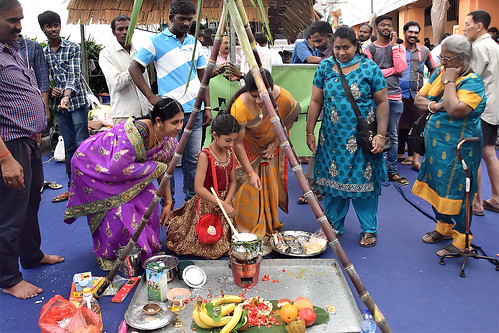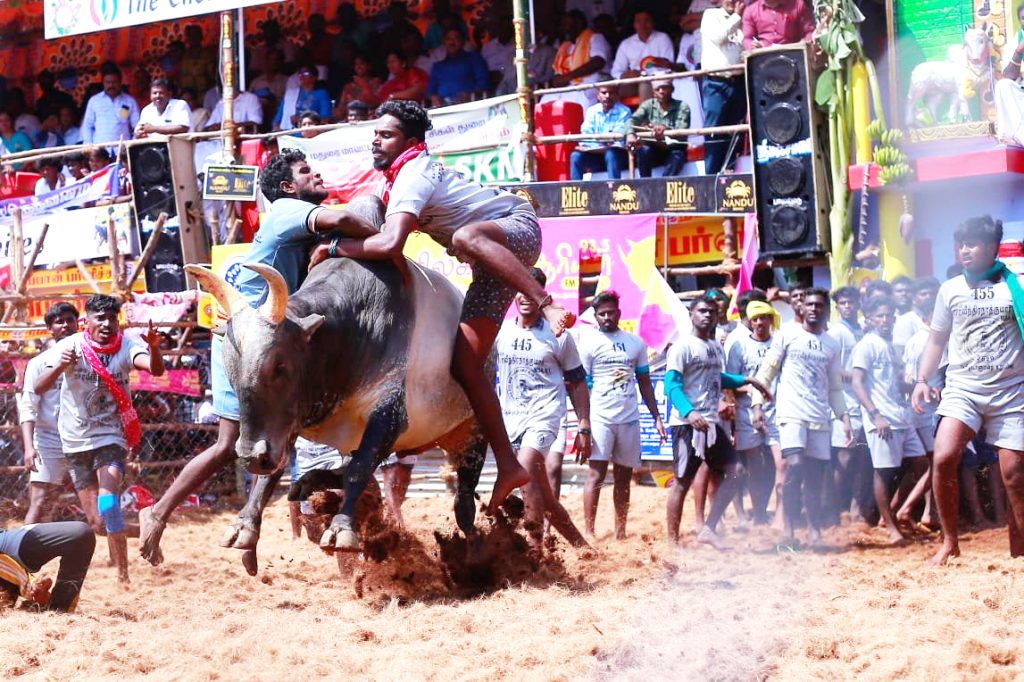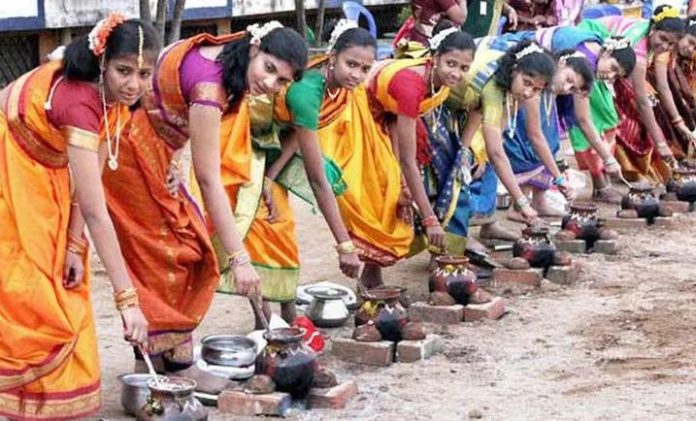Harvest time has also traditionally been festive time across India. There are several festivities associated with harvest in India, a time when joy prevails, when the family has benefitted from a good harvest and celebrities obviously come through. Such is the festival of Pongal.
Pongal is one of the most popular harvest festivals of South India, mainly in Tamil Nadu. Pongal falls in mid-January every year and marks the auspicious beginning of Uttarayan – sun’s journey northwards. Pongal festival lasts for four days. This festival in Tamil Nadu is celebrated to show gratitude to nature. The literal meaning of Pongal is “spilling over” and it has been named so, because of the tradition of boiling rice in a pot until it starts overflowing. Other traditions of the celebration include drawing of Kolam, swinging and cooking of delicious Pongal.
Pongal festival marks the end of cold winter months and the advent of spring. From this time the length of days gradually increases in the northern hemisphere. The celebration of Pongal lasts for four days from the last day of the Tamil month Margazhi (December-January) to the third day of Thai that is the month of January – February according to Western Calendar. It is the second and the main day of the festival that is celebrated as Pongal every year.
Pongal is celebrated when the fields are blooming. The festival is thus a celebration of prosperity and a good harvest, especially for the farming community. During the Pongal celebrations, farmers express their gratitude to Sun God and the cattle and thank them for a good harvest.
Other festivals
Harvest festivals have different names in different parts of the country. It is celebrated as Makar Sankranti in central India and Bhugali Bihu in Assam while people in West Bengal, celebrate the last day of Bengali month Paush on January 14 as Paush Parbon. Here, thousands of devotees take bath in Gangasagar, the point where the holy river Ganga meets the sea, to wash away all the earthly sins.
The harvest festival of Pongal falls in the month of January after the winter solstice. The date of the festival is derived from the Solar Calendar hence it usually remains the same. For Hindus, the date of Pongal is extremely auspicious and astronomically significant. Around January 14, every year sun begins its six-months-long journey northwards or in Uttarayan and moves into the zodiac Capricorn or Makara Rashi. This celestial event is celebrated as Pongal in South India.
History of Pongal
Pongal is an ancient festival of people in South India, particularly Tamils. The history of the festival can be traced back to the Sangam Age i.e. 200 BCE to 300 CE. While Pongal originated as a Dravidian harvest festival and has a mention in Sanskrit Puranas, historians identify the festival with the Thai Un and Thai Niradal which are believed to have been celebrated during the Sangam Age.
Pongal during the Sangam Era: The celebrations of Sangam Era led to today’s Pongal celebrations. As part of the festivities, maidens of the Sangam era observed ‘Pavai Nonbu’ at the time of Thai Niradal which was a major festival during the reign of the Pallavas (4th to 8th Century CE). It was observed during the Tamil month of Margazhi (December-January).
During this festival a young girl prayed for rain and prosperity of the country. Throughout the month, they avoided milk and milk products. They would not oil their hair and refrained from using harsh words while speaking. Women used to bathe early in the morning. They worshiped the idol of Goddess Katyayani, which would be carved out of wet sand. They ended their penance on the first day of the month of Thai (January-February). This penance was to bring abundant rains to flourish the paddy. These traditions and customs of ancient times gave rise to Pongal celebrations.


Andal’s Tiruppavai and Manickavachakar’s Tiruvembavai vividly describe the festival of Thai Niradal and the ritual of observing Pavai Nonbu. According to an inscription found in the Veeraraghava temple at Tiruvallur, the Chola King Kiluttunga used to give lands to the temple specially for the Pongal celebrations.
Legends of Pongal
Some legendary stories are also associated with Pongal festival celebrations. The two most popular legends of Pongal are stories related to Lord Shiva and Lord Indra.
According to a legend, once Shiva asked his bull, Basava, to go to the earth and ask the mortals to have an oil massage and bath every day and to eat once a month. Inadvertently, Basava announced that everyone should eat daily and have an oil bath once a month. This mistake enraged Shiva who then cursed Basava, banishing him to live on the earth forever. He would have to plough the fields and help people produce more food. Thus the association of this day with cattle.
Another legend of Lord Indra and Lord Krishna also led to Pongal celebrations. It is said when Lord Krishna was in his childhood, he decided to teach a lesson to Lord Indra who became arrogant after becoming the king of all deities. Lord Krishna asked all the cowherds to stop worshiping Lord Indra. This angered Lord Indra and sent forth his clouds for thunder-storms and 3 days continuous rains. Lord Krishna lifting Mount Govardhan to save all the humans. Later, Lord Indra realized his mistake and the divine power of Krishna.
Pongal celebrations
According to Hindu mythology, this is when the day of the gods begins, after a six-month long night. The festival is spread over three days and is the most important and most fervently-celebrated harvest festival of South India. A special puja is performed on the first day of Pongal before the cutting of the paddy. Farmers worship the sun and the earth by anointing their ploughs and sickles with sandalwood paste. It is with these consecrated tools that the newly-harvested rice is cut.
Each of the three days are marked by different festivities. The first day, Bhogi Pongal, is a day for the family. Surya Pongal, the second day, is dedicated to the worship of Surya, the Sun God. Boiled milk and jaggery is offered to the Sun God. The third day of Pongal, Mattu Pongal, is for worship of the cattle known as Mattu. Cattle are bathed, their horns polished and painted in bright colours, and garlands of flowers placed around their necks. The Pongal that has been offered to the Gods is then given to cattle and birds to eat.
FOUR DAYS OF PONGAL
1. Bhogi Festival
Bogi festival or Bhogi is the first day of Pongal and is celebrated in honour of Lord Indra, “the God of Clouds and Rains”. Lord Indra is worshiped for the abundance of harvest, thereby bringing plenty and prosperity to the land. Thus, this day is also known as Indran. On Bhogi all people clean out their homes from top to bottom, and collect all unwanted goods. This day is meant for domestic activities and for being together with the family members.


All the houses from the richest to the humblest are thoroughly scrubbed and whitewashed. Homes are cleaned and decorated with “Kolam” – floor designs drawn in the white paste of newly harvested rice with outlines of red mud. Often pumpkin flowers are set into cow-dung balls and placed among the patterns. Fresh harvest of rice, turmeric and sugarcane is brought in from the field as preparation for the following day.
Puja: A special puja is performed on the first day of Pongal before the cutting of paddy. Farmers worship the sun and the earth by anointing their ploughs and sickles with sandalwood paste. It is with these consecrated tools that the newly-harvested rice is cut.
The bonfire: Another ritual observed on this day is Bhogi Mantalu, when useless household articles are thrown into a fire made of wood and cow-dung cakes. Girls dance around the bonfire, singing songs in praise of the gods, the spring and the harvest. The significance of the bonfire, in which burnt agricultural wastes and firewood is to keep warm during the last lap of winter.
In Andhra Pradesh this day is celebrated by girls burning their old clothes and wearing the new ones after an oil massage and bath. Then follows Pongal Panai, a ritual in which new earthenware pots are painted and decorated with turmeric, flowers and mango leaves.
2. Surya Pongal
The second day of Pongal is known as ‘Surya Pongal’ and is dedicated to the Sun God. It is the day on which the celebration actually begins and is also the first day of the Tamil month Thai. On this day the granaries are full, the sun shines brightly, trees are in full bloom, bird-songs resound in the air and hearts overflow with happiness that get translated into colourful and joyous celebrations.
Puja preparation:
Women wake early on this day to create elaborate ‘kolam’ on the grounds in front of their doorway or home. Kolam is created with coloured rice flour placed on the ground carefully by using one’s hand. The women take several hours to finish the kolum. On this day the new rice is collected and cooked in pots until they overflow. It is this overflowing which means Pongal. This overflowing of rice is a joyous occasion, and the children and adults as well will shout out ‘Pongal-o-Pongal!’
3. Mattu Pongal
The third day of Pongal is dedicated to cattle and is called Mattu Pongal. People offer prayers to the bulls, cows and other farm animals. Cows and bulls have always held a special place in India. Cows give nourishing milk while bulls and oxen help plough the fields. Thus, Mattu Pongal is a day when cattle are given a well deserved day of rest and are given pride of place. Therefore the farmers honor their cattle friends by celebrating it as a day of thanks-giving to them.
Puja process:
The cattle are washed, their horns are painted and covered with shining metal caps. Multi-coloured beads, tinkling bells, sheaves of corn and flower garlands are tied around their necks. They are fed with Pongal and taken to the village centres. Devotees pay their respect to cows by bending down, like praying in temple, and touching their feet and foreheads, followed by an aarthi and offering the cattle prasadam.
Jallikattu- bull festival:
A festival called Jallikattu is held in Madurai, Tiruchirapalli and Thanjavur on this day. Bundles of money are tied to the horns of ferocious bulls which the villagers try to retrieve. Everyone joins in the community meal, at which the food is made of the freshly harvested grain. This day is named and celebrated as Tamizhar Tirunal in a fitting manner throughout Tamil Nadu.


4. Thiruvalluvar Day / Kanum Pongal
The fourth day of the three-day Pongal celebrations is called Kaanum Pongal. In a few places this day is also known as Karinaal or Thiruvalluvar Day. It is dedicated to the sun god, Surya and has its roots in ancient Brahmanical tradition. Since Pongal is a rural, agrarian based festival that celebrates the harvests, the sun is a vital part of the proceedings. This is because the Sun is the symbol of life on Earth. Without the Sun, crops cannot sprout and grow. Without the Sun, harvests will not be plentiful.
Customs and rituals: This day is very similar to Rakhsa Bandhan and Bhai Dhuj in that it is predominantly a festival where women offer prayers for the wellbeing of their brothers. The women perform this ritual before bathing in the morning. All the women, young and old, of the house, assemble in the courtyard. The rice is placed in the centre of the leaf, while the women ask that the house and family of their brothers should prosper. Arati is performed for the brothers with turmeric water, limestone and rice, and this water is sprinkled on the kolam in front of the house.
Pongal Recipes
The best of South Indian dishes are relished during the harvest festival of Pongal making the occasion a gourmet’s delight.
Sweet Rice: The making of sweet rice is the most important preparation. This is a dish prepared with rice, dal, jaggery, dry fruits, sugar and milk. All these ingredients are cooked in a new clay pot in the open and allowed to boil over, signifying plenty and prosperity for the year ahead. This is offered to the Sun God and partaken as prasad.
Ven Pongal: If you are a fan of savoury pongal, you just have to try this Ven Pongal recipe. Always wondered how to make khara pongal at home? This quick and easy pongal recipe will be your answer. Ready in just one hour, this Ven Pongal recipe is perfect to be served to your guests. You can also make this savoury pongal recipe on the days you are in no mood to plan an elaborate meal. Traditionally, this khara pongal recipe is cooked around the Pongal festival or Onam, however, the taste of this dish is so amazing that you can make it anytime. You can add your own twist of spices in this recipe. For instance, to add more aroma to this pongal recipe, dry roast the spices, grind them and then add to the dish.
Pongal Celebration Around the World
The harvest festival of Pongal is celebrated with enthusiasm by the Indians be it in India or any other country. Tamils living abroad follow their cultural values throughout their significant festival. It is great to note that even the younger generation of Tamils living abroad come forward to contribute to the development of this harvest festival. Through various contributions in celebrating Pongal, the Tamil diaspora maintains and nurtures the cultural distinctiveness.
Tamil Diaspora
The early settlement patterns of the Tamils could be traced to the sugar cane plantations of Mauritius, Reunion in the Indian Ocean; Jamaica, Trinidad and Tobago in the Caribbean; Guyana and Suriname in South America; plantations in South Africa; Malaysia; Ceylon (Sri Lanka); and to coal mines of New Caledonia off Australia. In Indonesia and Thailand. Britain with 300,000 or more, the USA with well over 300,000, Canada with over 300,000 and Australia with over 30,000 are some of the developed countries where the Tamil diaspora is well settled, having gone on voluntary migration from Tamil Nadu and Sri Lanka.
Worldwide Celebration:
- Pongal in South East Asia
- Pongal in Africa
- Pongal In Oceania
- Pongal in the Gulf
- Pongal in Europe
- Tamils in Americas
INTERNATIONAL NAMES - Korea – Chu’sok
- Japan – Tori no Ichi
- Sri Lanka -Pongal or Ulavar Thirunaal
- United States – Thanksgiving
- China – August Moon Festival
- Vietnam – Tet Trung Thu
- Israel – Succoth
- Africa America – Kwanzaa
- Africa – Yam Festival





















